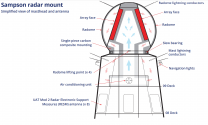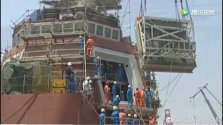Russian Fregat M2M or MAE-3 double-face radar weighs 2.5 tons. Weight of Sea Eagle should not be much different. What would be your estimate for weight of the new double-faced radar on 054B?
Significantly heavier given the new 054B array is a double sided AESA with much more volume behind the arrays.
Sea Eagle and the new twin face AESA were both tested on the same class of test ship (891 and 892 respectively), conveniently on the same location on the hull, allowing a rough scaled comparison of their size and their volume.
This is the comparison

This is the full side view of the mount, where the full solid volume of the rotating setup is visible, behind the arrays.

This is the volume and cross section of Sea Eagle

How much heavier is the new twin face array likely to be compared to Sea Eagle?
I'm not sure. But I guess it would be heavy enough such that I would be impressed if they were able to maintain the same mast height as Sea Eagle on a ship with only two meters greater beam than 054A.


